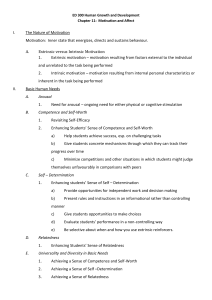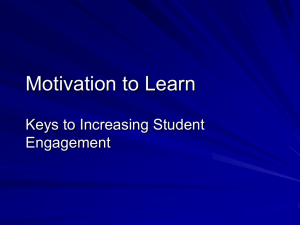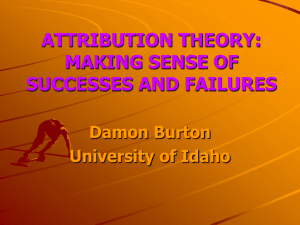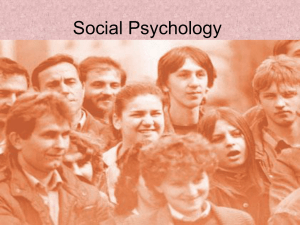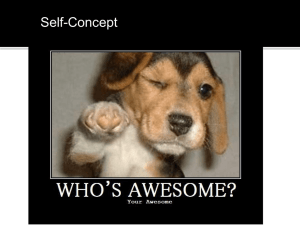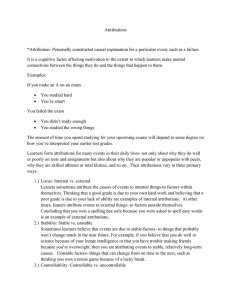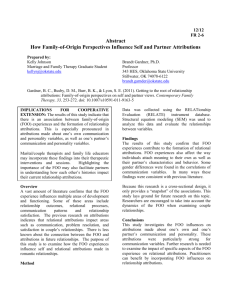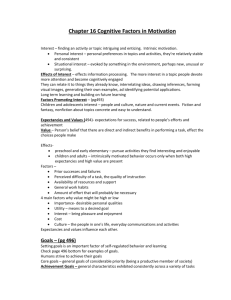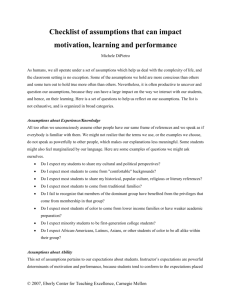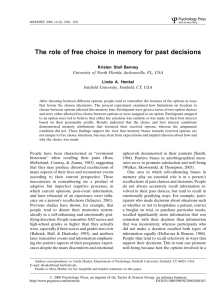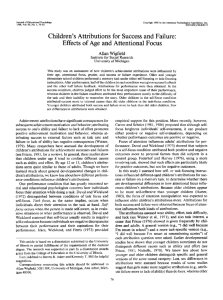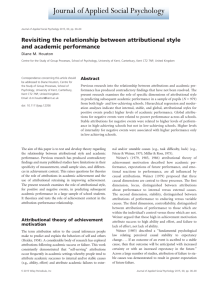Cognitive Factors in Motivation
advertisement
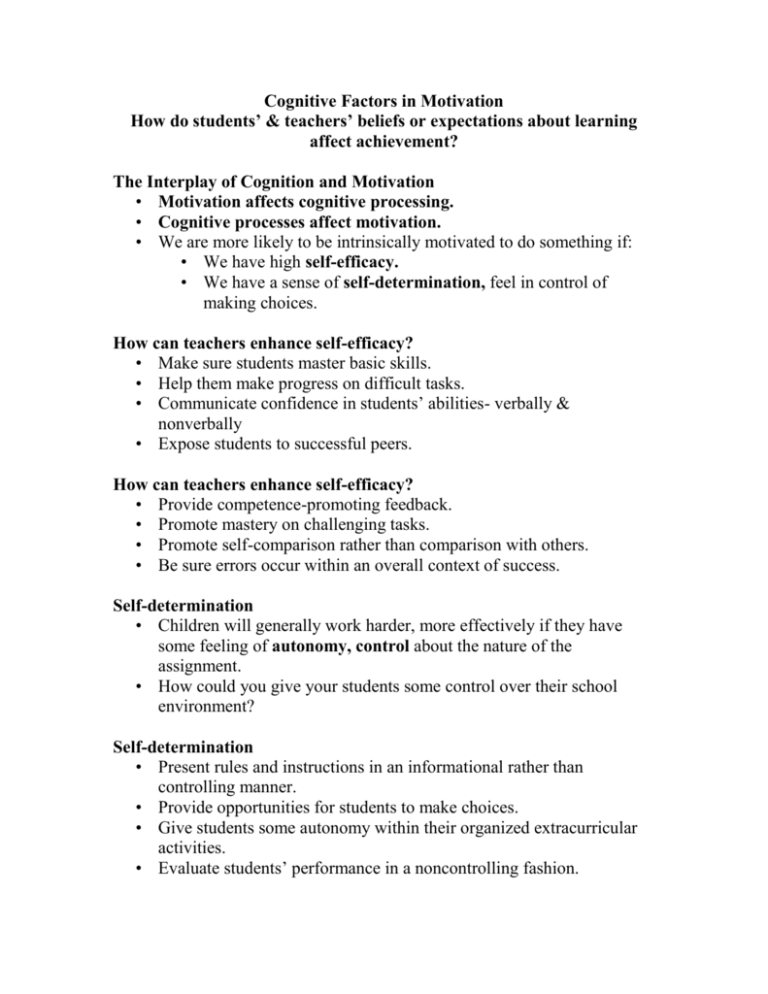
Cognitive Factors in Motivation How do students’ & teachers’ beliefs or expectations about learning affect achievement? The Interplay of Cognition and Motivation • Motivation affects cognitive processing. • Cognitive processes affect motivation. • We are more likely to be intrinsically motivated to do something if: • We have high self-efficacy. • We have a sense of self-determination, feel in control of making choices. How can teachers enhance self-efficacy? • Make sure students master basic skills. • Help them make progress on difficult tasks. • Communicate confidence in students’ abilities- verbally & nonverbally • Expose students to successful peers. How can teachers enhance self-efficacy? • Provide competence-promoting feedback. • Promote mastery on challenging tasks. • Promote self-comparison rather than comparison with others. • Be sure errors occur within an overall context of success. Self-determination • Children will generally work harder, more effectively if they have some feeling of autonomy, control about the nature of the assignment. • How could you give your students some control over their school environment? Self-determination • Present rules and instructions in an informational rather than controlling manner. • Provide opportunities for students to make choices. • Give students some autonomy within their organized extracurricular activities. • Evaluate students’ performance in a noncontrolling fashion. • Minimize reliance on extrinsic reinforcers, but use them when necessary. • Help students keep externally imposed constraints in proper perspective. Areas where children can make choices • Rules & procedures in class • Procedures used to achieve mastery • Topics for research/writing projects • Due dates on some assignments • The order in which tasks are accomplished • Ways of demonstrating mastery • Criteria for evaluation of project Importance of shifting reliance on intrinsic reinforcers • Reliance on external reinforcers undermines students’ feelings of pride in their accomplishments. • External reinforcers subtly communicate that class projects are “chores” rather than activities that can be enjoyed for their own sake. • Some external reinforcement may be necessary to encourage students to do the more mundane parts of the assignments. Expectancies and Values • Expectancy is a belief that one will be successful. It is affected by: • Past experience with similar tasks • Perceived difficulty of task • Support available, instruction quality • Effort necessary to succeed • Value is the perceived benefit to the student of performing the task. It is affected by: • One’s own identity as related to task • Task seen as means to a desired goal • Intrinsic pleasure of doing task Circumstances that decrease a task’s value • Task requires more effort than it is worth • Task doesn’t seem relevant to learner • Task becomes associated with bad feelings: frustration, humiliation • Unfortunately, most academic subjects decline in value over the school years, as students see little value in learning them. Internalizing the Values of Others • Process of internalized motivation • External regulation- consequences • Introjection- to gain approval • Identification- seeing the behavior as being personally valuable • Integration – the behavior has been integrated into an overall system of values Conditions that promote internalized motivation • Children need a warm, responsive, & supportive environment to develop relatedness to important people. • They need some degree of autonomy to feel self-determination in making decisions. • They need appropriate guidance & structure, feedback, & clear consequences for inappropriate behaviors- scaffolding. Fostering expectancies & values in the classroom • Teachers must: • model how academic achievements have benefited them. • Share their enthusiasm about subjects. • Demonstrate real-world application for subject matter. • Demonstrate the interesting nature of material. Interest • Interest- the enticing nature of topics- is a form of intrinsic motivation. • Situational interest- interest is evoked by something in the environment- things that are new, different, unexpected, or vivid. • Personal interest- relate to the student’s own activities & knowledge. This energizes much activity related to the topic. Promoting interest in Classroom Subjects • Allow some flexibility in topics students explore, in order to include personal interest • Tie some classroom subjects to things students are naturally interested in: • Topics related to people & culture, nature, animals, current events • Include variety in classroom materials Promoting interest in Classroom Subjects Present discrepant information • Encourage fantasy/ make-believe • Apply new knowledge to events in personal lives • Ask students to teach others what they have learned. Goals • People set goals for themselves & choose courses of action that may help them succeed. Core goals drive much of what we do. Goals are also: • Short-term, transitory • Long-term & enduring • Achieving goals enhances self-efficacy • Variety of goals in various domains- personal, social, physical, health, recognition, financial Goals • Mastery goal- a learning goal • Performance goal- desire to appear competent • Performance-approach goal is designed to receive favorable judgments. • Performance-avoidance goal is designed to avoid looking bad. Effects of Mastery & Performance Goals • Mastery- students pay attention, process in order to develop LTM, learn from mistakes, realize learning is a process & develop perseverance. • Performance- students avoid many tasks that could help them master new skills, feel serious anxiety in face of challenge. Fostering Mastery Goals • Unfortunately, many teachers & parents methods of “motivating” students actually promote development of performance goals- stress on grades, future outcomes, competition with peers, grading on a curve. • Better to stress usefulness of information, the process of learning includes difficulty but is beneficial to learner in the end. Work-Avoidance Goals • The purpose of the work-avoidance goal is to put as little effort as possible into that task: • Off-task behavior • Getting help on easy tasks • Pretending one doesn’t understand • Choosing the easiest alternatives • Due to low self-efficacy, lack of interest Social Goals • Forming relationships with others • Becoming part of a group • Gaining other’s approval • Achieving status among peers • Supporting others • Depending on which peers are chosen, academics can be heightened or diminished. Career Goals • Boys generally set higher goals for themselves than girls, especially in masculine domains. This is changing. • Girls raised in traditional cultures often limit themselves to traditionally feminine occupations, considering impact on family. • Teachers can open up the possibilities to students with career education, feedback & encouragement. Capitalizing on Students’ Goals • Plan activities that enable students to meet several goals at oncesocial & academic. • Relate classroom subject matter to students’ present lives & future goals. • Students learn more when they have a personal need to know the material. • Encourage students to set specific, short-term goals for their learning & achievement. Attributions: Perceived Causes of Success & Failure • Attributions are people's beliefs about what causes what. These beliefs drive behavior. • Attributions are used to explain one’s successes and failures. • They can be irrational, not in concert with actual evidence: impostor syndrome. Dimensions of Attributions • Locus of control • Internal • External • Stability • Stable • Unstable • Controllability • Controllable • Uncontrollable Attributions • Attributional style can protect one’s self-worth: • Internal attributions for successes, & external attributions for failures. • Or it can defeat a student with real potential: • External attributions for successes, & internal attributions for failures. • Blaming others for one’s failures can become a habit, thoughsociopathic & resistant to feedback How Attributions Influence Affect, Cognition, & Behavior • Emotional reactions to success & failure • Expectations for future success or failure • Expenditure of effort • Help-seeking behavior • Classroom performance • Future choices Developmental Trends in Attributions • It takes some years to distinguish between ability & effort. By age 9 they understand that effort can compensate for ability. • By 13 they understand that in some areas, a lack of ability can’t be overcome by effort. • As they age they tend to attribute more to ability than effort. Beginning students believe they can learn anything by trying hard. • In school, if failures are common, self-efficacy declines, along with effort. • Intelligence: • Entity view vs. incremental view Factors that Influence Attributional Style • Past successes & failures • Learned industriousness- a series of tasks that they can succeed at only with considerable effort. • Reinforcement & punishment • Better to reinforce successes & not punish failures • Messages from adults • We communicate that we believe students are capable or will fail. Feedback states what we believe about ability or effort. • Image management- face saving • Students tailor excuses to what the teacher will most likely not react negatively about- illness, family chaos Mastery Orientation vs. Learned Helplessness • Mastery orientation is an attributional style that credits one’s ability & effort- an ‘I can do it’ style. They set higher goals, seek change, persist in face of failure. • Learned helplessness is an attributional style of futility about one’s chances for success- an ‘I can’t do it’ style. • They set easy goals, avoid challenges, underestimate their abilities, give up quickly. • This is not common before age 8. Having many resources available for dealing with academic challenges helps this. Teacher Expectations & Attributions • Teachers form opinions about students’ abilities, strengths, & weaknesses early in the school year. They underestimate: • Those who are unattractive • Who misbehave in class • Who speak in dialects • Who are members of minorities • Who are recent immigrants • Who come from lower SES backgrounds Other problems with teacher expectations • Teachers often hold an entity view of intelligence. • Once they develop a negative view about a child, they behave noticeably differently. Body language. • When they believe children have high ability: • They create a warmer environment, interact with students more often, give more opportunities for students to respond, give more positive feedback, cover more challenging topics. • When they believe children have little potential: • They give them few opportunities for speaking in class, ask easier questions, give less feedback to student responses, present few challenging assignments. Self-fulfilling Prophecy • Children live up to or down to the expectations others hold for them: self-fulfilling prophecy. This has the greatest impact in early elementary years and early secondary year- transitions. • But sometimes students achieve in order to show the teacher- prove their worth. • Parents may need to step in to clarify the child’s problem and ask teacher to change behavior. Forming Positive Expectations & Attributions for Student Performance • Remember that teachers definitely make a difference. • Look for strengths in every student. • Communicate optimistic & controllable attributions. • Learn more about students’ backgrounds & home environments. • Assess students’ progress regularly & objectively. Consider Diversity • Ethnic differences• affect values, future expectations & attributions • Gender differences• affect effort depending on whether task is seen as gender appropriate & long-term goals. Girls tend to underestimate their abilities in male domains. Girls are more easily discouraged by failures than boys. Due to gender socialization in explanatory patterns. • Socioeconomic differences• Consider the examples you use- are lower SES children familiar with them? Do they see activities as relevant? • Students with special-needs • These students need greater self-determination, so we need to offer them more choices, develop greater independence skills.
